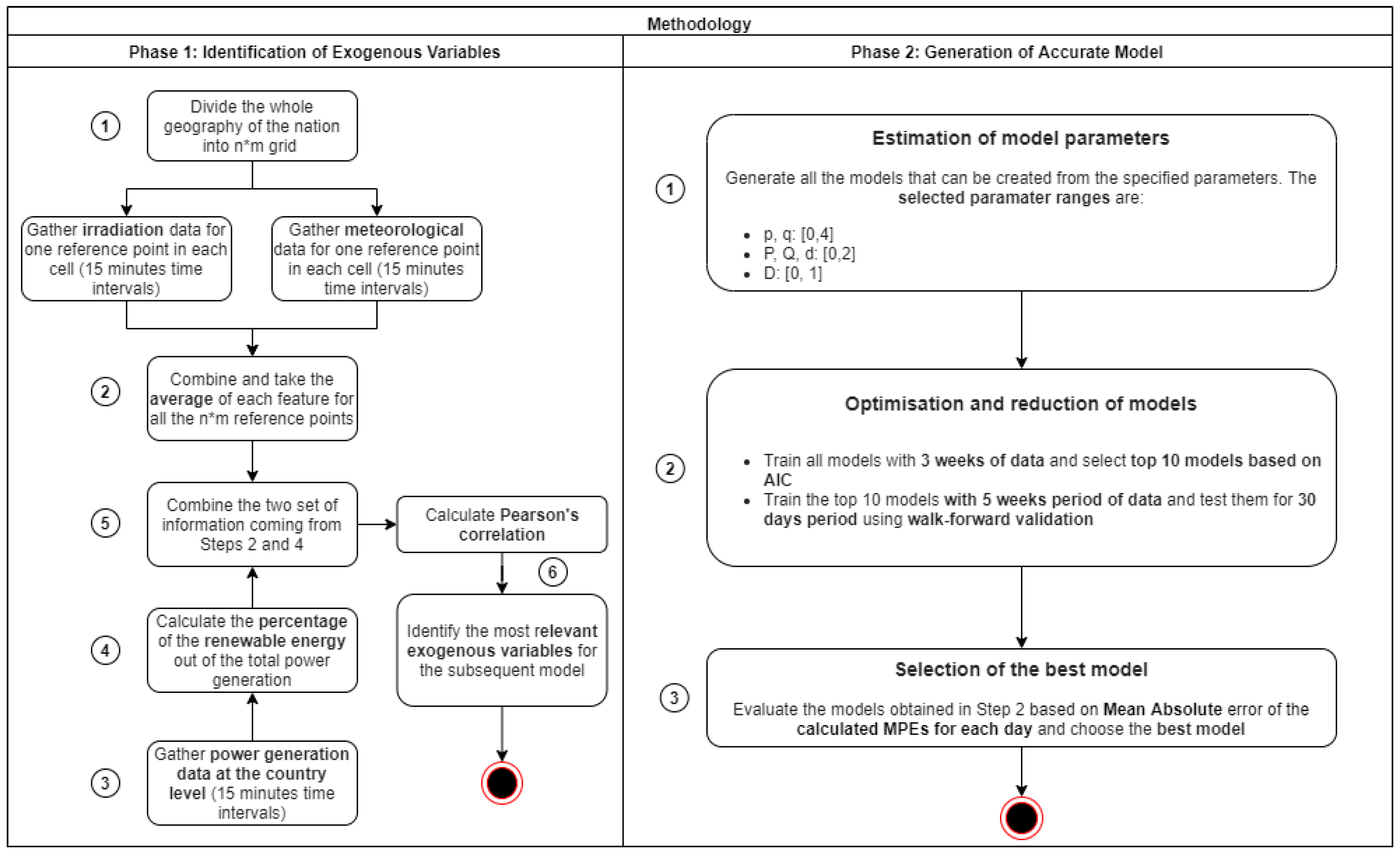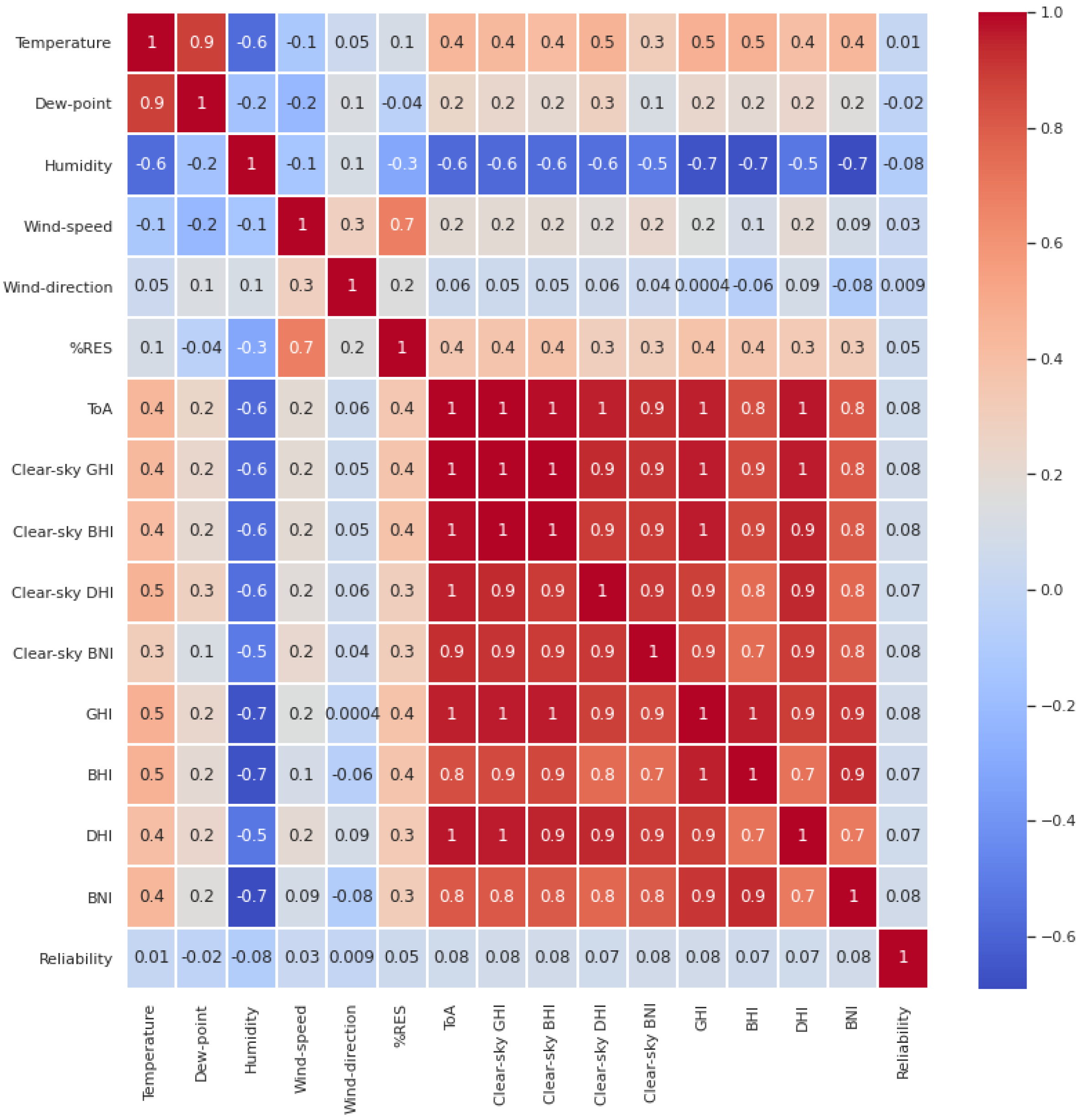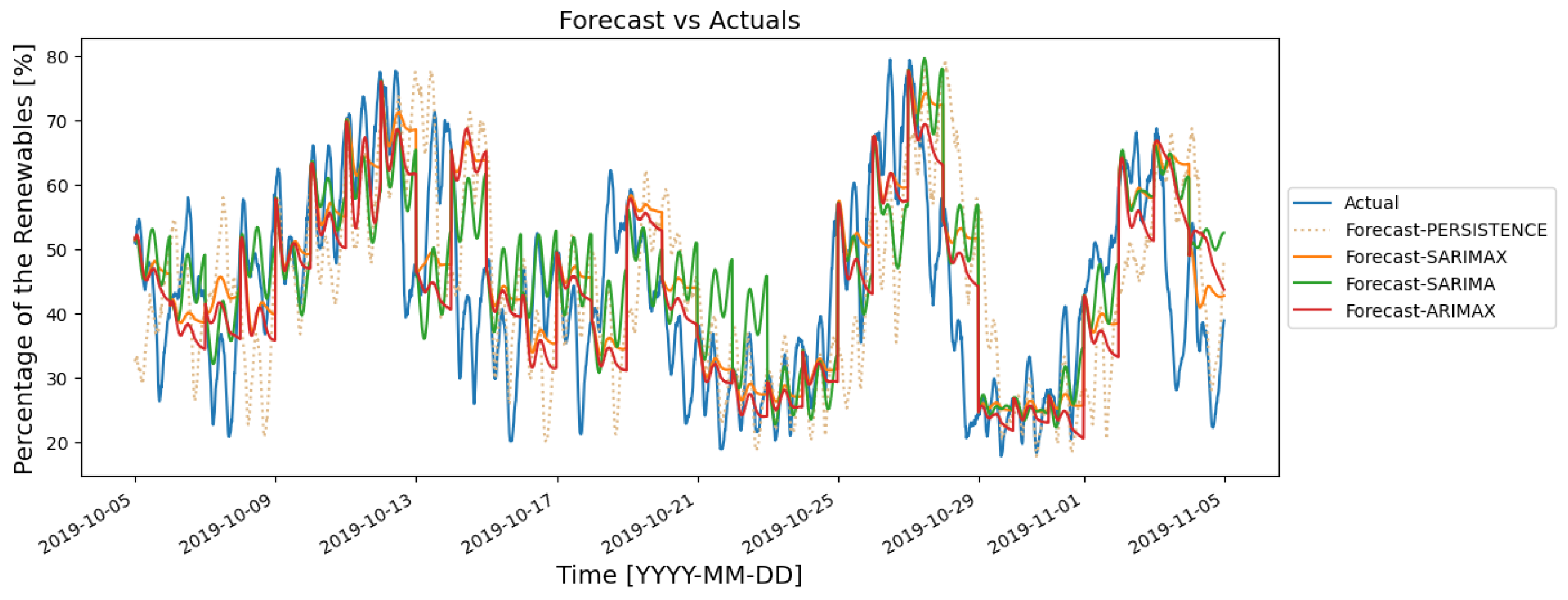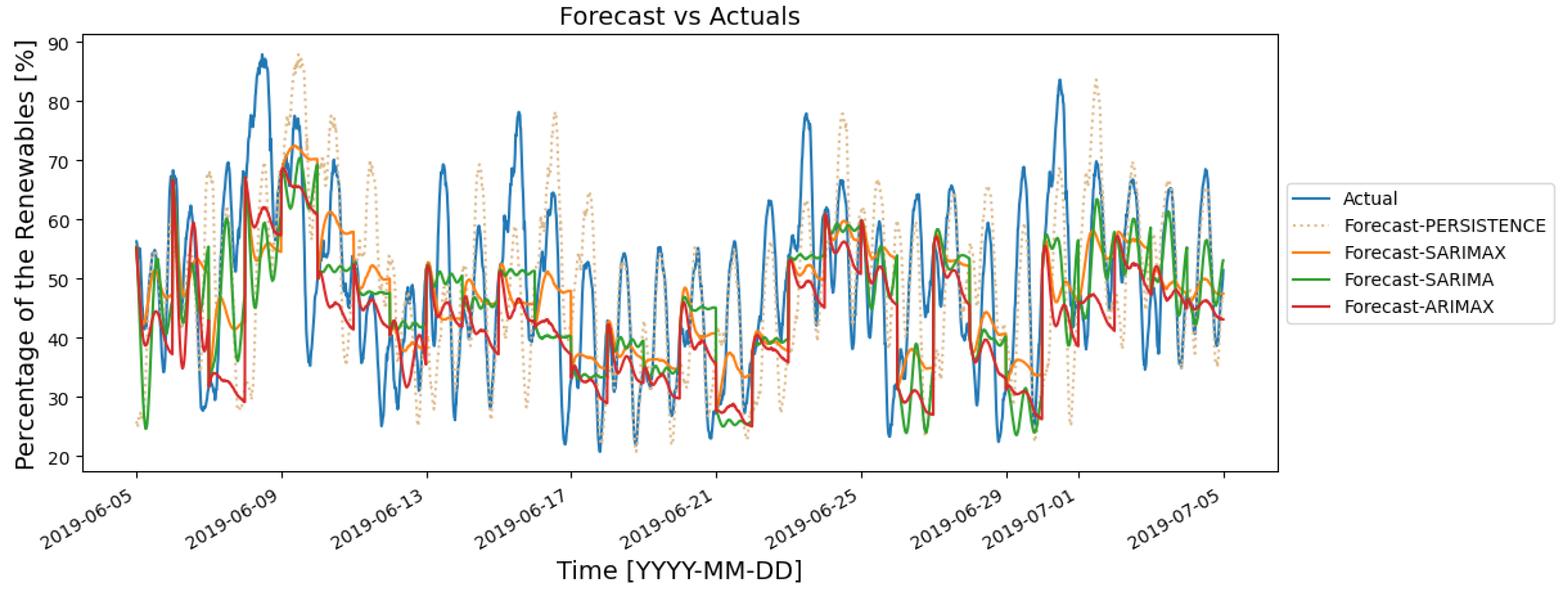Day-Ahead Forecasting of the Percentage of Renewables Based on Time-Series Statistical Methods
Abstract
:1. Introduction
1.1. Motivation
1.2. Problem Statement and Research Questions
- Given the fact that power generation from renewables are dependent on weather conditions, what is the minimum number of meteorology-related variables that are required to forecast the generation from different types of renewables?
- Among the three considered time-series regression-based methods, which one is more suitable and under what seasonal conditions?
1.3. Contributions
- Derivation of a methodology whose main objective is to generate the best auto regressive-based model for each month of the year;
- Identification of the minimum number of meteorology-related variables required by the seasonal auto regressive-based models through correlation analysis;
- Optimisation of the model parameters and provision of the best auto regressive-based model under study for each month of the year;
- Implementation of the best generated models in an open-source REN4KAST software platform (https://github.com/ren4kast/REN4KAST accessed on 5 November 2021), which provides a service to forecast the percentage of RES.
2. Related Work
3. Proposed Methodology
3.1. Phase 1: Identification of Exogenous Variables
3.2. Phase 2: Generation of Accurate Model
- ,
- and ,
- .
3.3. Comparison among Models
4. Correlation Analysis of the Features
4.1. Definition
4.2. Data Sources
- The distance between any two points in the grid should not exceed 250 km. This is because, within a circular range of 250 km, the cities in this region have very similar weather conditions;
- Points as cities are chosen which have the least missing data from the collected sources, as well as preferably at the center of the circular region.
4.3. Correlated Variables
5. Evaluation
5.1. Implementation
- NVIDIA Tesla P100 GPU: base and maximum frequencies of 1190 MHz and 1330 MHz respectively;
- DRAM of 28 GB capacity: minimum and effective frequencies of 715 MHz and 1430 MHz respectively.
5.2. Obtained Results
5.2.1. Inter-Day Analysis
5.2.2. Intra-Day Analysis
5.3. Sensitivity Analysis
5.4. Other Observations
5.4.1. Same Models for Different Years
5.4.2. Best Model of Each Month
5.4.3. Forecasting Day-ahead Power Generation from Renewables
6. Conclusions and Future Work
Author Contributions
Funding
Institutional Review Board Statement
Informed Consent Statement
Data Availability Statement
Acknowledgments
Conflicts of Interest
Abbreviations
| AIC | Akaike information criterion |
| API | Application program interface |
| ANN | Artificial neural network |
| ARIMAX | Auto regressive integrated moving average with exogeneous input |
| BHI | Beam horizontal irradiation |
| BNI | Beam normal-incidence irradiation |
| CAMS | Copernicus atmosphere monitoring service |
| DHI | Diffuse horizontal irradiation |
| DSM | Demand-side management |
| ENTSOE | European network of transmission system operators for electricity |
| EV | Electric vehicle |
| FFNN | Feed-forward neural network |
| GHI | Global horizontal irradiation |
| GRU | Gated recurrent units |
| HI | Horizontal irradiation |
| LSTM | Long short-term memory |
| MA | Mean absolute |
| MAE | Mean average error |
| MPE | Mean percentage error |
| MRE | Mean relative error |
| NEAT | Neuro evolution of augmenting topologies |
| PV | Photovoltaic |
| RBFN | Radial basis function network |
| RES | Renewable energy sources |
| RMSE | Root mean square error |
| SARIMA | Seasonal auto regressive integrated moving average |
| SARIMAX | Seasonal auto regressive integrated moving average with exogeneous input |
| SSE | Sum of squared errors |
| ToA | Top of atmosphere |
Appendix A. Time-Series Modeling
Appendix A.1. Definition
Appendix A.2. Data Driven Models
Appendix A.2.1. Auto Regressive Integrated Moving Average
Appendix A.2.2. Auto Regressive Integrated Moving Average eXogenous
Appendix A.2.3. Seasonal ARIMA
Appendix A.2.4. Seasonal ARIMAX
Appendix A.3. Accuracy Measuring Metrics
Appendix A.3.1. Mean Absolute Error
Appendix A.3.2. Root Mean Square Error
Appendix A.3.3. Mean Percentage Error
Appendix A.3.4. Mean of the Errors
Appendix A.3.5. Mean Absolutes
| Model—Month | Mean Absolute | Mean Absolute | Mean Absolute | Mean Absolute |
|---|---|---|---|---|
| of the Errors [%] | of the MPEs [%] | of the RMSEs [%] | of the MAEs [%] | |
| SARIMAX —January | 7.69 | 28.09 | 10.06 | 8.70 |
| SARIMA —January | 7.64 | 26.30 | 10.03 | 8.62 |
| ARIMAX —January | 8.33 | 23.07 | 10.60 | 9.19 |
| Persistence—January | 12.04 | 32.98 | 14.85 | 13.44 |
| SARIMAX —February | 6.18 | 18.20 | 9.15 | 7.66 |
| SARIMA —February | 5.92 | 17.52 | 9.23 | 7.63 |
| ARIMAX —February | 6.03 | 14.78 | 9.01 | 7.39 |
| Persistence—February | 7.71 | 20.11 | 10.81 | 9.42 |
| SARIMAX —March | 7.43 | 14.94 | 10.41 | 8.43 |
| SARIMA —March | 7.26 | 14.68 | 10.64 | 8.57 |
| ARIMAX —March | 6.88 | 13.53 | 10.35 | 8.10 |
| Persistence—March | 8.44 | 18.37 | 12.01 | 10.38 |
| SARIMAX —April | 4.60 | 9.73 | 8.40 | 6.76 |
| SARIMA —April | 6.35 | 12.22 | 9.27 | 7.53 |
| ARIMAX —April | 4.47 | 10.03 | 8.80 | 7.11 |
| Persistence—April | 5.65 | 12.50 | 8.19 | 7.25 |
| SARIMAX —May | 7.89 | 15.88 | 11.77 | 9.69 |
| SARIMA —May | 9.85 | 19.09 | 13.24 | 11.08 |
| ARIMAX —May | 7.09 | 14.79 | 11.53 | 9.35 |
| Persistence—May | 7.68 | 16.44 | 12.88 | 9.84 |
| SARIMAX —June | 6.54 | 15.76 | 12.46 | 10.15 |
| SARIMA —June | 6.32 | 13.25 | 11.32 | 9.40 |
| ARIMAX —June | 8.59 | 17.32 | 14.26 | 11.57 |
| Persistence—June | 7.59 | 16.38 | 12.97 | 11.04 |
| SARIMAX —July | 5.03 | 12.96 | 10.66 | 8.68 |
| SARIMA —July | 4.99 | 11.50 | 11.01 | 8.88 |
| ARIMAX —July | 5.64 | 12.06 | 10.97 | 8.74 |
| Persistence—July | 6.46 | 15.97 | 9.28 | 8.20 |
| SARIMAX —August | 5.56 | 11.88 | 12.19 | 9.57 |
| SARIMA —August | 4.87 | 12.75 | 10.17 | 8.14 |
| ARIMAX —August | 6.16 | 13.11 | 12.63 | 9.91 |
| Persistence—August | 6.64 | 15.43 | 10.06 | 8.78 |
| SARIMAX —September | 6.38 | 15.12 | 10.16 | 8.21 |
| SARIMA —September | 6.41 | 14.79 | 10.02 | 8.22 |
| ARIMAX —September | 6.57 | 15.96 | 11.22 | 8.95 |
| Persistence—September | 8.32 | 20.07 | 11.65 | 10.17 |
| SARIMAX —October | 6.80 | 18.54 | 9.23 | 7.80 |
| SARIMA —October | 6.54 | 18.46 | 8.95 | 7.48 |
| ARIMAX —October | 7.20 | 19.88 | 10.34 | 8.58 |
| Persistence—October | 8.62 | 22.77 | 12.85 | 11.47 |
| SARIMAX —November | 8.81 | 29.61 | 11.13 | 9.42 |
| SARIMA —November | 8.34 | 28.58 | 10.69 | 9.03 |
| ARIMAX —November | 8.51 | 28.63 | 10.93 | 9.22 |
| Persistence—November | 10.13 | 33.79 | 14.74 | 13.07 |
| SARIMAX —December | 10.48 | 26.01 | 13.20 | 11.29 |
| SARIMA —December | 10.03 | 24.71 | 12.75 | 10.91 |
| ARIMAX —December | 10.45 | 25.83 | 13.20 | 11.32 |
| Persistence—December | 8.84 | 19.97 | 13.16 | 11.64 |
References
- Mehrasa, M.; Pouresmaeil, E.; Pournazarian, B.; Sepehr, A.; Marzband, M.; Catalão, J.P.S. Synchronous Resonant Control Technique to Address Power Grid Instability Problems Due to High Renewables Penetration. Energies 2018, 11, 2469. [Google Scholar] [CrossRef] [Green Version]
- Basmadjian, R. Flexibility-Based Energy and Demand Management in Data Centers: A Case Study for Cloud Computing. Energies 2019, 12, 3301. [Google Scholar] [CrossRef] [Green Version]
- Yukseltan, E.; Yucekaya, A.; Bilge, A.H. Hourly electricity demand forecasting using Fourier analysis with feedback. Energy Strategy Rev. 2020, 31, 100524. [Google Scholar] [CrossRef]
- Ciechulski, T.; Osowski, S. High Precision LSTM Model for Short-Time Load Forecasting in Power Systems. Energies 2021, 14, 2983. [Google Scholar] [CrossRef]
- Ciechulski, T.; Osowski, S. Deep Learning Approach to Power Demand Forecasting in Polish Power System. Energies 2020, 13, 6154. [Google Scholar] [CrossRef]
- Zhang, D.; Tong, H.; Li, F.; Xiang, L.; Ding, X. An Ultra-Short-Term Electrical Load Forecasting Method Based on Temperature-Factor-Weight and LSTM Model. Energies 2020, 13, 4875. [Google Scholar] [CrossRef]
- Li, R.; Chen, X.; Balezentis, T.; Streimikiene, D.; Niu, Z. Multi-step least squares support vector machine modeling approach for forecasting short-term electricity demand with application. Neural Comput. Appl. 2021, 33, 301–320. [Google Scholar] [CrossRef]
- Jiang, P.; Li, R.; Lu, H.; Zhang, X. Modeling of electricity demand forecast for power system. Neural Comput. Appl. 2020, 32, 6857–6875. [Google Scholar] [CrossRef]
- Basmadjian, R.; Kirpes, B.; Mrkos, J.; Cuchy, M. A Reference Architecture for Interoperable Reservation Systems in Electric Vehicle Charging. Smart Cities 2020, 3, 1405–1427. [Google Scholar] [CrossRef]
- Eider, M.; Sellner, D.; Berl, A.; Basmadjian, R.; de Meer, H.; Klingert, S.; Schulze, T.; Kutzner, F.; Kacperski, C.; Stolba, M. Seamless Electromobility. In Proceedings of the Eighth International Conference on Future Energy Systems; ACM: New York, NY, USA, 2017; pp. 316–321. [Google Scholar]
- Scheu, M.N.; Kolios, A.; Fischer, T.; Brennan, F. Influence of statistical uncertainty of component reliability estimations on offshore wind farm availability. Reliab. Eng. Syst. Saf. 2017, 168, 28–39. [Google Scholar] [CrossRef]
- Neves, D.; Brito, M.C.; Silva, C.A. Impact of solar and wind forecast uncertainties on demand response of isolated microgrids. Renew. Energy 2016, 87, 1003–1015. [Google Scholar] [CrossRef]
- González-Aparicio, I.; Zucker, A. Impact of wind power uncertainty forecasting on the market integration of wind energy in Spain. Appl. Energy 2015, 159, 334–349. [Google Scholar] [CrossRef]
- Bauer, P.; Thorpe, A.; Brunet, G. The quiet revolution of numerical weather prediction. Nature 2015, 525, 47–55. [Google Scholar] [CrossRef] [PubMed]
- Basmadjian, R.; de Meer, H. Evaluating and modeling power consumption of multi-core processors. In Proceedings of the 2012 Third International Conference on Future Systems: Where Energy, Computing and Communication Meet (e-Energy), Madrid, Spain, 9–11 May 2012; pp. 1–10. [Google Scholar] [CrossRef]
- Basmadjian, R.; de Meer, H. Modelling and Analysing Conservative Governor of DVFS-Enabled Processors. In Proceedings of the Ninth International Conference on Future Energy Systems; Association for Computing Machinery: New York, NY, USA, 2018; pp. 519–525. [Google Scholar] [CrossRef]
- Basmadjian, R.; Rainer, S.; Meer, H.D. A Generic Methodology to Derive Empirical Power Consumption Prediction Models for Multi-Core Processors. In Proceedings of the 2013 International Conference on Cloud and Green Computing, Karlsruhe, Germany, 30 September–2 October 2013; pp. 167–174. [Google Scholar] [CrossRef]
- Lara-Benítez, P.; Carranza-García, M.; Luna-Romera, J.M.; Riquelme, J.C. Temporal Convolutional Networks Applied to Energy-Related Time Series Forecasting. Appl. Sci. 2020, 10, 2322. [Google Scholar] [CrossRef] [Green Version]
- Ghofrani, M.; Suherli, A. Time series and renewable energy forecasting. Time Ser. Anal. Appl. 2017, 2017, 77–92. [Google Scholar]
- Deb, C.; Zhang, F.; Yang, J.; Lee, S.E.; Shah, K.W. A review on time series forecasting techniques for building energy consumption. Renew. Sustain. Energy Rev. 2017, 74, 902–924. [Google Scholar] [CrossRef]
- Hyndman, R.; Athanasopoulos, G. Forecasting: Principles and Practice, 2nd ed.; OTexts: Melbourne, Australia; Available online: OTexts.com/fpp2 (accessed on 5 November 2021).
- Alsharif, M.H.; Younes, M.K.; Kim, J. Time series ARIMA model for prediction of daily and monthly average global solar radiation: The case study of Seoul, South Korea. Symmetry 2019, 11, 240. [Google Scholar] [CrossRef] [Green Version]
- Atique, S.; Noureen, S.; Roy, V.; Subburaj, V.; Bayne, S.; Macfie, J. Forecasting of total daily solar energy generation using ARIMA: A case study. In Proceedings of the 2019 IEEE 9th annual computing and communication workshop and conference (CCWC), Las Vegas, NV, USA, 7–9 January 2019; pp. 0114–0119. [Google Scholar]
- Vagropoulos, S.I.; Chouliaras, G.; Kardakos, E.G.; Simoglou, C.K.; Bakirtzis, A.G. Comparison of SARIMAX, SARIMA, modified SARIMA and ANN-based models for short-term PV generation forecasting. In Proceedings of the 2016 IEEE International Energy Conference (ENERGYCON), Leuven, Belgium, 4–8 April 2016; pp. 1–6. [Google Scholar]
- Hodge, B.M.; Zeiler, A.; Brooks, D.; Blau, G.; Pekny, J.; Reklatis, G. Improved wind power forecasting with ARIMA models. In Computer Aided Chemical Engineering; Elsevier: Amsterdam, The Netherlands, 2011; Volume 29, pp. 1789–1793. [Google Scholar]
- Basmadjian, R. Communication Vulnerabilities in Electric Mobility HCP Systems: A Semi-Quantitative Analysis. Smart Cities 2021, 4, 405–428. [Google Scholar] [CrossRef]
- Kirpes, B.; Danner, P.; Basmadjian, R.; de Meer, H.; Becker, C. E-Mobility Systems Architecture: A Framework for Managing Complexity and Interoperability. Energy Inform. 2019, 2, 15. [Google Scholar] [CrossRef]
- Hassan, M.Z.; Ali, M.E.K.; Ali, A.S.; Kumar, J. Forecasting day-ahead solar radiation using machine learning approach. In Proceedings of the 2017 4th Asia-Pacific World Congress on Computer Science and Engineering (APWC on CSE), Mana Island, Fiji, 11–13 December 2017; pp. 252–258. [Google Scholar]
- Singh, V.P.; Vijay, V.; Bhatt, M.S.; Chaturvedi, D. Generalized neural network methodology for short term solar power forecasting. In Proceedings of the 2013 13th International Conference on Environment and Electrical Engineering (EEEIC), Wroclaw, Poland, 1–3 November 2013; pp. 58–62. [Google Scholar]
- Basmadjian, R.; De Meer, H. A Heuristics-Based Policy to Reduce the Curtailment of Solar-Power Generation Empowered by Energy-Storage Systems. Electronics 2018, 7, 349. [Google Scholar] [CrossRef] [Green Version]
- Basmadjian, R. Optimized Charging of PV-Batteries for Households Using Real-Time Pricing Scheme: A Model and Heuristics-Based Implementation. Electronics 2020, 9, 113. [Google Scholar] [CrossRef] [Green Version]
- Eldali, F.A.; Hansen, T.M.; Suryanarayanan, S.; Chong, E.K. Employing ARIMA models to improve wind power forecasts: A case study in ERCOT. In Proceedings of the 2016 North American Power Symposium (NAPS), Denver, CO, USA, 18–20 September 2016; pp. 1–6. [Google Scholar]
- Akaike, H. A new look at the statistical model identification. IEEE Trans. Autom. Control 1974, 19, 716–723. [Google Scholar] [CrossRef]
- Mishra, A.; Desai, V. Drought forecasting using stochastic models. Stoch. Environ. Res. Risk Assess. 2005, 19, 326–339. [Google Scholar] [CrossRef]
- Pearson, K. Notes on the History of Correlation. Biometrika 1920, 13, 25–45. [Google Scholar] [CrossRef]
- Brownlee, J. Introduction to Time Series Forecasting with Python: How to Prepare Data and Develop Models to Predict the Future; Machine Learning Mastery, 2017; Available online: https://books.google.de/books?id=bA5ItAEACAAJ (accessed on 5 November 2021).
- Demirhan, H.; Renwick, Z. Missing value imputation for short to mid-term horizontal solar irradiance data. Appl. Energy 2018, 225, 998–1012. [Google Scholar] [CrossRef]
- European Network of Transmission System Operators for Electricity (Enstoe). Available online: https://transparency.entsoe.eu/ (accessed on 5 November 2021).
- Grinberg, M. Flask Web Development: Developing Web Applications with Python; O’Reilly Media, Inc.: Sebastopol, CA, USA, 2018. [Google Scholar]
- Kattan, A.; Fatima, S.; Arif, M. Time-series event-based prediction: An unsupervised learning framework based on genetic programming. Inf. Sci. 2015, 301, 99–123. [Google Scholar] [CrossRef]







| Method | Execution Time | Number of Models |
|---|---|---|
| SARIMAX | 4 h and 30 min | 1350 |
| SARIMA | 3 h | 1350 |
| ARIMAX | 5 min | 75 |
| Method | Execution Time | Number of Models |
|---|---|---|
| SARIMAX | 3 h | 10 |
| SARIMA | 1 h and 30 min | 10 |
| ARIMAX | 1 h and 15 min | 10 |
| Variable | Explanation and Unit |
|---|---|
| GHI | Global irradiation on a horizontal plane (Wh/m) |
| BHI | Beam irradiation on a horizontal plane at ground level (Wh/m) |
| DHI | Diffuse irradiation on a horizontal plane at ground level (Wh/m) |
| BNI | Weather Beam irradiation on a mobile plane following the sun at normal incidence (Wh/m) |
| ToA | Atmospheric radiation received by a horizontal surface outside the atmosphere (Wh/m) |
| Reliability | Proportion of reliable data (0–1) |
| Clear-sky GHI | Clear-sky global irradiation on a horizontal plane at ground level (Wh/m) |
| Clear-sky BHI | Clear-sky beam irradiation on horizontal plane at ground level (Wh/m) |
| Clear-sky DHI | Clear-sky diffuse irradiation on horizontal plane at ground level (Wh/m) |
| Clear-sky BNI | Clear-sky beam irradiation on a mobile plane following the sun at normal incidence (Wh/m) |
| Variable | Explanation and Unit |
|---|---|
| Humidity | The ratio of partial to equilibrium pressure of water vapor at a given temperature (%) |
| Dew-point | Describes the amount of moisture in the air (mm) |
| Temperature | Weather temperature (ºC) |
| Wind-speed | Wind flow speed (km/h) |
| Wind-direction | The direction from which the wind is coming from (degrees) |
| Month | Model |
|---|---|
| January | SARIMA |
| February | ARIMAX |
| March | ARIMAX |
| April | SARIMAX |
| May | ARIMAX |
| June | SARIMA |
| July | SARIMAX |
| August | SARIMA |
| September | SARIMAX |
| October | SARIMA |
| November | SARIMA |
| December | SARIMA |
| Model | Mean Absolute | Mean Absolute | Mean Absolute | Mean Absolute |
|---|---|---|---|---|
| of the Errors [%] | of the MPEs [%] | of the RMSEs [%] | of the MAEs [%] | |
| SARIMAX (summer) | 4.76 | 9.97 | 10.51 | 8.30 |
| SARIMA (summer) | 5.09 | 10.32 | 11.41 | 8.93 |
| ARIMAX (summer) | 4.78 | 10.25 | 10.54 | 8.31 |
| Persistence (summer) | 6.08 | 15.67 | 8.71 | 7.67 |
| SARIMAX (autumn) | 7.07 | 19.46 | 10.35 | 8.58 |
| SARIMA (autumn) | 7.23 | 19.56 | 9.57 | 8.15 |
| ARIMAX (autumn) | 7.36 | 20.14 | 10.48 | 8.74 |
| Persistence (autumn) | 9.35 | 23.92 | 12.88 | 11.63 |
| Model | Testing Date | Mean Error [%] | MPE [%] | RMSE [%] | MAE [%] |
|---|---|---|---|---|---|
| SARIMAX (summer) | 11 July2019 | −0.40 | −6.30 | 5.36 | 4.50 |
| SARIMAX (summer) | 21 July 2019 | 8.39 | 2.57 | 19.47 | 16.82 |
| SARIMAX (autumn) | 29 October 2019 | −1.65 | −8.41 | 3.25 | 2.44 |
| SARIMAX (autumn) | 14 October 2019 | −23.03 | −63.23 | 25.05 | 23.03 |
| Model | Exogenous Variable(s) | Mean Error % | MPE | RMSE | MAE |
|---|---|---|---|---|---|
| January | Both | 8.33 | 23.07 | 10.60 | 9.19 |
| GHI | 8.36 | 21.73 | 10.80 | 9.25 | |
| Wind-speed | 8.27 | 22.78 | 10.57 | 9.15 | |
| February | Both | 6.03 | 14.78 | 9.01 | 7.39 |
| GHI | 6.51 | 18.00 | 9.27 | 7.84 | |
| Wind-speed | 6.11 | 15.45 | 9.26 | 7.52 | |
| March | Both | 6.88 | 13.53 | 10.35 | 8.10 |
| GHI | xx | xx | xx | xx | |
| Wind-speed | 6.87 | 13.59 | 10.70 | 8.37 | |
| April | Both | 4.47 | 10.03 | 8.80 | 7.11 |
| GHI | 4.55 | 10.09 | 8.85 | 7.14 | |
| Wind-speed | 4.79 | 10.36 | 9.61 | 7.63 | |
| May | Both | 7.09 | 14.79 | 11.53 | 9.35 |
| GHI | 7.23 | 15.11 | 11.69 | 9.49 | |
| Wind-speed | 7.45 | 14.84 | 12.59 | 10.19 | |
| June | Both | 8.59 | 17.32 | 14.26 | 11.57 |
| GHI | 8.70 | 17.45 | 14.36 | 11.65 | |
| Wind-speed | 9.03 | 17.43 | 15.05 | 12.17 | |
| July | Both | 5.64 | 12.06 | 10.97 | 8.74 |
| GHI | 5.73 | 12.20 | 11.08 | 8.84 | |
| Wind-speed | 6.19 | 12.18 | 12.23 | 9.73 | |
| August | Both | 6.16 | 13.11 | 12.63 | 9.91 |
| GHI | 6.79 | 14.31 | 13.16 | 10.44 | |
| Wind-speed | 5.26 | 12.63 | 13.01 | 10.57 | |
| September | Both | 6.57 | 15.96 | 11.22 | 8.95 |
| GHI | 6.60 | 15.98 | 11.32 | 9.04 | |
| Wind-speed | 5.26 | 12.63 | 13.01 | 10.57 | |
| October | Both | 7.20 | 19.88 | 10.34 | 8.58 |
| GHI | 7.08 | 19.66 | 10.35 | 8.58 | |
| Wind-speed | 7.59 | 19.76 | 12.09 | 9.68 | |
| November | Both | 8.51 | 28.63 | 10.93 | 9.22 |
| GHI | 8.56 | 28.77 | 10.96 | 9.26 | |
| Wind-speed | 8.30 | 28.12 | 10.76 | 9.04 | |
| December | Both | 10.45 | 25.83 | 13.20 | 11.32 |
| GHI | 10.43 | 25.76 | 13.14 | 11.28 | |
| Wind-speed | 10.06 | 25.01 | 12.83 | 10.92 |
| Model | Mean Absolute | Mean Absolute | Mean Absolute | Mean Absolute |
|---|---|---|---|---|
| of the Errors [%] | of the MPEs [%] | of the RMSEs [%] | of the MAEs [%] | |
| SARIMAX—(2019) | 5.84 | 12.59 | 12.86 | 9.94 |
| SARIMA—(2019) | 6.52 | 13.99 | 12.32 | 10.08 |
| ARIMAX—(2019) | 7.53 | 13.15 | 13.24 | 10.75 |
| Persistence—(2019) | 7.23 | 15.06 | 11.79 | 10.11 |
| SARIMAX—(2020) | 6.82 | 14.50 | 12.10 | 9.90 |
| SARIMA—(2020) | 7.95 | 15.05 | 12.98 | 12.54 |
| ARIMAX—(2020) | 7.80 | 14.48 | 12.76 | 10.42 |
| Persistence—(2020) | 8.54 | 18.08 | 11.37 | 10.00 |
| Model | Mean Absolute | Mean Absolute | Mean Absolute | Mean Absolute |
|---|---|---|---|---|
| of the Errors [MW] | of the MPEs [%] | of the RMSEs [MW] | of the MAEs [MW] | |
| SARIMAX (Jan.) | 4280.23 | 16.23 | 5955.59 | 4885.47 |
| SARIMA (Jan.) | 4308.06 | 16.36 | 6038.57 | 4927.70 |
| ARIMAX (Jan.) | 4285.68 | 16.15 | 5976.68 | 4905.17 |
| SARIMAX (Nov.) | 7429.93 | 37.32 | 10,447.35 | 7905.16 |
| SARIMA (Nov.) | 5502.95 | 26.49 | 7264.97 | 6045.49 |
| ARIMAX (Nov.) | 7042.42 | 35.12 | 9147.59 | 7401.43 |
| SARIMAX (Dec.) | 5679.29 | 22.42 | 7172.82 | 6014.19 |
| SARIMA (Dec.) | 5562.20 | 22.42 | 7172.64 | 6027.94 |
| ARIMAX (Dec.) | 5373.38 | 21.31 | 6970.78 | 5857.59 |
Publisher’s Note: MDPI stays neutral with regard to jurisdictional claims in published maps and institutional affiliations. |
© 2021 by the authors. Licensee MDPI, Basel, Switzerland. This article is an open access article distributed under the terms and conditions of the Creative Commons Attribution (CC BY) license (https://creativecommons.org/licenses/by/4.0/).
Share and Cite
Basmadjian, R.; Shaafieyoun, A.; Julka, S. Day-Ahead Forecasting of the Percentage of Renewables Based on Time-Series Statistical Methods. Energies 2021, 14, 7443. https://doi.org/10.3390/en14217443
Basmadjian R, Shaafieyoun A, Julka S. Day-Ahead Forecasting of the Percentage of Renewables Based on Time-Series Statistical Methods. Energies. 2021; 14(21):7443. https://doi.org/10.3390/en14217443
Chicago/Turabian StyleBasmadjian, Robert, Amirhossein Shaafieyoun, and Sahib Julka. 2021. "Day-Ahead Forecasting of the Percentage of Renewables Based on Time-Series Statistical Methods" Energies 14, no. 21: 7443. https://doi.org/10.3390/en14217443
APA StyleBasmadjian, R., Shaafieyoun, A., & Julka, S. (2021). Day-Ahead Forecasting of the Percentage of Renewables Based on Time-Series Statistical Methods. Energies, 14(21), 7443. https://doi.org/10.3390/en14217443








